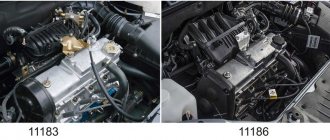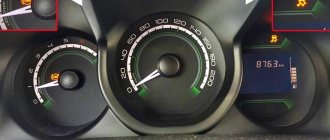It is generally accepted that in our country the most popular body type is the sedan. We will not dispute this thesis, but we cannot but agree that station wagons are becoming increasingly popular. This is not surprising - in terms of comfort and safety, they are in no way inferior to sedans, liftbacks, hatchbacks and other cars, characterized by increased cargo transportation capabilities. That is why we decided to compare two domestically produced cars that represent this segment in the budget B-class.
Technical features of the models
To make the comparison objective, we selected cars with the same 106-horsepower engines and manual transmissions
| Largus | Granta | |
| Power unit volume, l. | 1,599 | 1,596 |
| Power, l. With. | 106 | 106 |
| Max cr. torque, Nm at rpm | 148/4200 | 148/4000 |
| Luggage compartment volume, l. | 300 | 361 |
| Length, cm | 447 | 412 |
| Height, cm. | 167 | 154 |
| Wheelbase, see | 290 | 248 |
| Clearance, see | 14,5 | 16,0 |
Exterior
The appearance of Lada Largus is perceived ambiguously. Some are impressed by the severity of the lines, others see features of expansiveness in the updated appearance. Of course, the front is not without the signature radiator grille and an enlarged block for fog lights. The faceted lines of the body panels modernize the appearance of the station wagon, as do the enlarged wheel arches. Such associations are facilitated by embossed bumpers, massive sills, and the presence of plastic overlays on both bumpers.
In a word, the design of the car’s exterior was a great success, and this cannot but rejoice. Especially considering that you can choose between a five- and seven-seat option.
The Lada Granta is also considered a typical B-class station wagon according to the European classification, but only in a five-seater version. The target audience of the car is married couples, possibly with children, or people who need a car ideally suited for cargo transportation.
The station wagon Granta appeared in this family quite recently - in the fall of 2022. The car premiered during the Moscow Auto Show, and almost immediately it became available in showrooms. You shouldn’t expect a separate individuality from Grant’s appearance - it’s still the same, but elongated sedan, which, in turn, is a restyled version of the second generation Lada Kalina.
In any case, the front view is absolutely identical to the sedan of the same name, characterized by a signature X-like design. The profile view, for obvious reasons, could not remain unchanged, as could the stern. Here you can note the large lights extending onto both the wings and the trunk lid, as well as the large glass area of the car.
It is unlikely that we will take the liberty of saying whose exterior is prettier, the Largus or the Grants - both station wagons look stylish and modern.
Comparative technical parameters Sedan and Liftback
| Name | Lada Granta Sedan (mm) | Lada Granta Liftback (mm) |
| Wheelbase size | 2450 | 2450 |
| body length | 4265 | 4276 |
| height | 1500 | 1500 |
| width | 1700 | 1700 |
| clearance | 161 | 176 |
| full mass | 1120 (kg) | 1179 (kg) |
Salon and trunk
Since Largus is an adapted variation of the Dacia Logan MCV station wagon, its interior is strikingly reminiscent of Logan’s. Of course, all the flaws in ergonomics migrated here: the location of the power window control buttons was not on the doors, but on the center console, the rear ones also managed to be shoved between the driver and passenger seats, the sound signal was placed on the steering column switch. Finally, the button for turning on the heated seats is hidden so that you can only find it by touch. Finally, the windshield washer button is located separately from the wiper button.
However, compared to other Lada models, the Largus interior looks more modern and comfortable. Only those who have previously driven a foreign car, and of a higher class, will be dejected.
Lada Largus salon
The station wagon is available in two forms: five- and seven-seater. The back of the third row sofa, like that of the Romanian progenitor, folds and is removed in the same way. The pillow itself is located quite low, so it’s even more comfortable to sit here than in front. At the station wagon. Unlike the sedan, the rear of the car is not narrowed vertically, so the gallery will be comfortable for tall passengers. This is facilitated by its own cup holders and the presence of an air duct to the feet from the climate system. In addition, the rear windows also open, which is rare for station wagons. Sitting in the third row is not as comfortable as we would like, but nothing can be done about it.
If desired, the backrest of the third row can be lowered (fully or half) or removed altogether using just two latches. In principle, the same operation can be performed for the second row, but here you will need a wrench. But the size of the luggage compartment will increase to 2540 liters.
The interior of the Lada Granta station wagon is practically no different from that of the sedan, characterized by a very attractive and modern design, carefully thought-out ergonomics and good build quality. However, the finishing materials here are frankly cheap, and the back row of seats will be a bit cramped for three adults of large build.
Salon of Lada Granta
With the rear seat folded down, the luggage compartment volume will increase from 360 to 670 liters. Hidden under the trunk floor is a set of essential tools and a full-size spare tire.
Interior
Why is the Granta Liftback better than the Granta Sedan in terms of interior: in many ways, the interior of both models is identical. The quality of the plastic is good, the gap at the joints is insignificant. The standard radio of type 2 is worthy of attention - DIMM on the Liftback, in the Sedan form factor 1 - DIMM. The standard package includes:
- immobilizer;
- seat belt sensor;
- headlight hydrocorrector;
- sound notification of the presence of a key in the ignition switch.
The instrument panel has acquired a visor, now the sun's rays will not illuminate the readings of the on-board computer, tachometer, and speedometer. At the bottom of the central channel there are two cup holders, an ashtray, and a 12 V input for connecting third-party gadgets, charging smartphones and tablets. The shape of the seats is identical, but the upholstery has become more pleasant to the touch, and there are inserts for air circulation. The parking brake lever has finally received a cast handle, it looks more attractive, more powerful, and merges with the central channel.
The rear row of seats folds in a 60/40 ratio, regardless of modification. Which is convenient and practical when transporting oversized cargo. A full-size spare wheel, a mechanical jack, and a wheel wrench are stowed in the luggage compartment under a soundproofing layer. In the budget packages Norma and Standard are only additional. The difference is significant; purchasing a full-fledged wheel requires additional costs.
Engines and transmissions
It just so happens that most Lada models have one common engine - a 106-horsepower 1.6-liter sixteen-valve engine. By the way, this is the only Largus station wagon.
Three engines are installed on Grant:
- eight-valve 87-horsepower, coupled with a five-speed manual gearbox;
- 16-valve 98-horsepower engine, paired with a four-speed automatic transmission;
- a basic 106-horsepower power unit, which can be equipped with either a manual transmission or a five-speed AMT robotic gearbox.
Note that the first two engines for the universal Granta will be rather weak, and the 106-horsepower engine does not demonstrate much agility - in order to quickly accelerate, you will need to spin the engine to 3 thousand revolutions or higher. But even when fully loaded, Granta will not have problems moving in dense city traffic.
The advantage of this unit is its high elasticity, which allows you to move at low speeds without bothering to change gears, and this feature is clearly manifested also on Largus.
As for the five-speed manual, even after a number of upgrades it is not distinguished by good accuracy and selectivity. The robotic gearbox, being an improved mechanics, also does not demonstrate miracles, but has several modes that both beginners and experienced drivers will surely enjoy.
So it is incorrect to compare Largus and Granta in terms of power unit - the latter model simply has a quantitative advantage.
Dynamics, fuel consumption
The maximum speed of the Largus station wagon is 162 km/h. If you use LPG (and more and more car owners are deciding to take this step due to rising gasoline prices), then the “maximum speed” will drop to 155 km/h. It will take 13.7 and 14.5 seconds to reach a speed of 100 km/h, respectively.
Fuel consumption in the city, highway and combined cycle will be 9.9/6.4/7.7 liters AI-92 and 10.5/6.5/8.0 liters of liquefied gas per 100 km. mileage
The Granta has the following dynamics and fuel consumption indicators:
| MT/106 hp | AMT/106 | AT/98 | |
| Acceleration, sec. | 10,7 | 12,2 | 13,1 |
| Max speed, km/h | 182 | 182 | 176 |
| Average consumption, l/100 km | 6,5 | 6,5 | 7,2 |
As you can see, the comparison is not in favor of Largus - Granta is clearly faster and more economical.
Suspension and chassis
For both models the characteristics are identical:
- drive type: front;
- front: independent, MacPherson type;
- rear: dependent, lever;
- brake system: front disc, rear drum type;
- wheel size: 175 / 70 R13;
- fuel consumption: 5.3 highway, 6.4 average;
- acceleration to hundreds: 10.8 sec.
Lada Granta Liftback is equipped with one of two types of suspension:
- oil shock absorbers;
- gas-filled.
What is the difference between shock absorbers: gas shock absorbers perform off-road somewhat better than oil shock absorbers. When it hits a hole, the car does not shake, the absorption is soft and as complete as possible.
Controllability and safety
The chassis of the Lada Largus station wagon has retained the excellent properties of the Logan suspension: high energy intensity and an amazing ability not to feel all the delights of domestic roads. But with a fully loaded trunk (and 550 kg is no joke!) you will not only feel and hear road bumps.
Lada Largus
With regard to minor defects, the suspension is too stiff; wheels getting into yaks and cracks will be accompanied by a characteristic knock and inexpressive shocks.
But stiffer shock absorbers and springs for a station wagon are a vital necessity, because both the mass of the car and its load capacity are much higher than that of a sedan.
As for handling, the Largus is average - the impression is spoiled by the too flimsy steering wheel: despite the presence of a hydraulic booster, it does not provide the driver with the opportunity to enjoy active driving.
As for the Lada Granta, here too, thanks to the reconfiguration of the electric power steering and shock absorbers, it was possible to achieve a noticeable improvement in handling. However, there is nothing outstanding here either, although the overall impressions of handling can be called positive.
Lada Granta
The Granta's suspension is expectedly energy-intensive: it swallows potholes without noticing them, but when driving at high speed, the car gives a slight shudder, and the noise level becomes threatening.
The verdict: the Largus has better suspension and handling, which is not surprising, since it was inherited from the legendary Romanian-French station wagon.
It's good what we don't have
Two sensational cars that recently appeared in public court, in most cases, directly compromised their creator - AvtoVAZ. Either it’s really the inability of the domestic auto industry to create something like this, or it’s the peculiarities of the Russian mentality. “You can’t understand Russia with your mind” - this statement was and is still not clear to me. But now it dawns on me: we always contradict ourselves.
For example, Daewoo Lanos, the creation of the Ukrainian ZAZ, was once zealously discussed on the Internet. And there is still an opinion that this car, to put it mildly, is far from perfect even in the Ukrainian or Russian understanding of the word. But what I see is that some “unlucky people” who purchased Granta repent of their actions, citing the fact that Lanos is better.
You just wonder how this can be, if all the disadvantages that are described by the owners of the Granta Lada on the website https://club-lada-granta.ru or the same Largus Lada practically coincide with the shoals that exist in Lanos. And this is not surprising, because AvtoVAZ and ZAZ are descendants of one parent - the Union of Soviets. And they had one school. But, be that as it may, time moves forward, the latest technologies are developing, and the same VAZ management understands that it is necessary to change and improve. They change and develop, so that it’s not like that joke about the Germans. The Germans bought AvtoVAZ and started producing Mercedes, but they ended up with Zhiguli.
Options and prices
Well, it's time to compare the cost and equipment of the Grant and Largus station wagons.
Let's start with Largus - there are only three trim levels:
- Norma Comfort costs 869 thousand rubles and includes two front airbags, three rear head restraints, Isofix seat mounts, an immobilizer, and a child locking function for the rear doors.
- Luxe can be purchased for 890 thousand, and you additionally receive an on-board computer, power accessories for exterior mirrors, fog lights, adjustable driver's seat with lumbar support, power windows on all doors, central locking with remote control.
- Prestige, priced from 900 thousand rubles, includes 15-inch alloy wheels and a leather steering wheel.
Granta has four basic configurations, but there are quite a few combined ones that differ in engine/transmission combination (we will not list them in order to save time):
- Standard, 467 thousand rubles, includes a driver's airbag, 14-inch steel wheels, Isofix type mount, audio preparation, ERA-GLONASS system.
- Classic, 500 thousand, added electric power steering, front electric windows, tilt steering wheel, BC with an indicator signaling the right moment to change gears, central locking.
- Comfort, 546 thousand rubles, added car radio, second airbag, heated front seats, electric exterior mirrors with integrated turn signals.
- Luxe, 585 thousand, added foglights, alloy wheels, full power accessories, climate control, alarm, immobilizer, remote central locking, heated windshield, folding back of the sofa in a 6/4 ratio, height adjustment of the driver's seat.
As you can see, Largus is more expensive. But the Grant station wagon is also more expensive than a sedan, although not by much.
What to choose: Lada Largus or Lada Granta
In many respects, station wagons are equal. Largus is more reliable and roomy; there is a choice of 5- or 7-seater options. This car is more reliable, it has better handling and energy-intensive suspension.
In favor of the Grant, one can note much greater possibilities in terms of choosing a power unit and transmission, greater efficiency, and in terms of maintenance/repair, the long version of the sedan is preferable.
In a word, the choice is yours, and if the main factor is cost, then Granta is much cheaper with comparable sets of options. Whether you need to overpay for a greater level of comfort and belonging to models completely developed on the basis of a foreign car is also up to you to decide.











